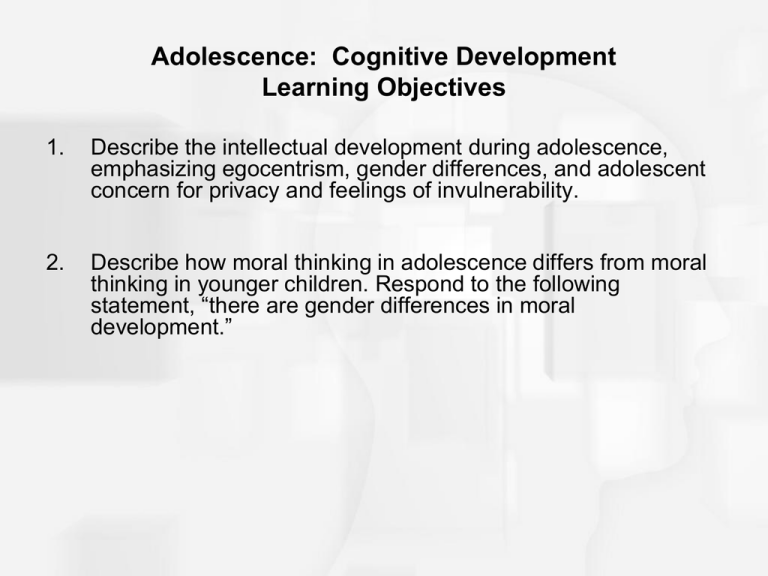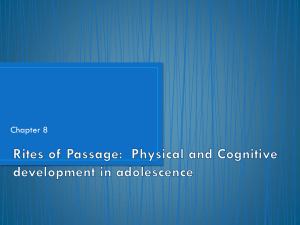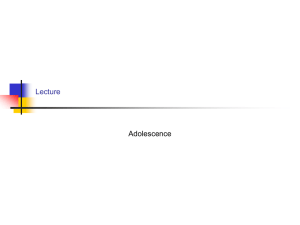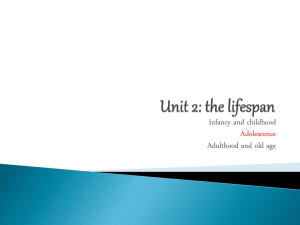
Adolescence: Cognitive Development
Learning Objectives
1.
Describe the intellectual development during adolescence,
emphasizing egocentrism, gender differences, and adolescent
concern for privacy and feelings of invulnerability.
2.
Describe how moral thinking in adolescence differs from moral
thinking in younger children. Respond to the following
statement, “there are gender differences in moral
development.”
Adolescence: Cognitive Development
Learning Objectives
3.
Discuss the adolescent transition into high school by explaining
how their transition affects both boys and girls, identifying dropout rates, and citing causes for dropping out of high school.
4.
Discuss factors influencing employment choices after high
school and describe the gender differences in employment
rates and career outlook.
Adolescence: Cognitive Development
Truth or Fiction?
Many adolescents see themselves as being on stage.
It is normal for male adolescents to think of themselves as
action heroes and to act as though they are made of steel.
Adolescence: Cognitive Development
Truth or Fiction?
Adolescent boys outperform adolescent girls in mathematics.
Most adolescents make moral decisions based on their own
ethical principles and may choose to disobey the laws of the land
if they conflict with their principles.
Adolescence: Cognitive Development
Truth or Fiction?
The transition from elementary school is more difficult for boys
than for girls.
It is advisable for parents to help adolescents complete their
homework.
Adolescence: Cognitive Development
Truth or Fiction?
Adolescents who work after school obtain lower grades.
The Adolescent in Thought
My, My, How “Formal”
What Is Meant by the Stage of Formal Operations?
• Cognitive maturity in Piaget’s theory
• Major achievements
– Classification
– Logical thought and deductive reasoning
– Ability to hypothesize
• Can think about abstract ideas
• Hypothetical thinking
– Can project beyond immediate experience
– Involved in lengthy fantasies and “what if” scenarios
Lessons in Observation: Piaget’s
Formal Operational Stage
• Explain the different ways in which preadolescents and
adolescents address the question “What if people had no
thumbs?”
• Describe how these different answers illustrate the idea of
Piaget’s stage of formal operations.
What Is Meant by the Stage of Formal Operations?
• Hypothetical thinking
– Can project beyond immediate experience
• Wrapped up in lengthy fantasies
•
•
•
•
Sophisticated use of symbols
Understand, create and use metaphors
Deductive reasoning in moral judgments
Utopian thinking
A Closer Look - Research
The Puzzle and the Pendulum
The Pendulum Problem
Figure 15.1
Reevaluation of Piaget’s Theory
• Changes in reasoning do occur during this age
• Formal operational thought is not universal
– Abstract thinking is more prevalent in technological societies
• May occur later than Piaget suggests, or not at all
• Do not apply formal operational thought with unfamiliar tasks
How Is Adolescent Egocentrism Shown in the
Imaginary Audience and in the Personal Fable?
• Imaginary Audience
– Belief that others are concerned with our appearance and behaviors
– May account for desire for privacy
– Explains preoccupation with appearance
• Personal Fable
– Our feelings and ideas are special
– Invulnerability
• Encourages risk-taking behaviors
What Are the Sex Differences in Cognitive Abilities?
• Females excel in verbal ability
– Girls acquire language earlier
– Boys more likely to have reading problems
• Boys excel in visual-spatial ability
– Visualize objects and mentally manipulate them
– Difference is greatest on mental rotation tasks
• Origins of the sex differences
– Biological
– Evolutionary
– Gender stereotypes
Examples of Tests Used to
Measure Visual-Spatial Ability
Figure 15.2
What Are the Sex Differences in Cognitive Abilities?
• No sex differences for performance in math
– Most Americans have different expectation for boys and girls
• Girls tend to be more vulnerable when confronted with difficult
math problems
• Sex differences are represented by group, not individual differences
• Sex differences represent cultural expectations
Women Flood Professions Once Populated
Almost Exclusively by Men
Figure 15.3
The Adolescent in Judgment
Moral Development
What Are Kohlberg’s Views on
Moral Reasoning in Adolescence?
• Postconventional Level
– Based on person’s own moral standards
– Stage 5 Contractual-legalistic orientation
• Laws are agreed upon, but rights should not be violated
– Stage 6 Universal ethical principles
• Reciprocity
The Case of Heinz
Figure 15.4
Age and Type of Moral Judgment
Figure 15.5
Cross-Cultural Differences In Moral Development
• Post-conventional thinking more likely found in urban cultural
groups and middle-class populations
• Self-oriented moral judgment in individualistic cultures
• Caring orientation in cultures with greater emphasis on others
Sex Differences In Moral Development
• Carol Gilligan – sex difference reflects patterns of socialization
– Female – socialized to focus on need of others – caring
– Male – socialized to focus on justice
• Does this difference represent a deficiency?
Is There a Relationship Between Moral Cognitive
Development and Moral Behavior?
• Positive relationship between moral development and behavior
• Postconventional does not appear until age 13
– Formal-operational thinking may be a prerequisite
– Education may play a role
Evaluation of Kohlberg’s Theory
• Research supports moral development in sequence
– Although most children do not reach postconventional level
• Kohlberg advocated an innate sequence; universal
– Underestimated influence of social, cultural, and education
institutions
• Postconventional thinking is all but absent in developing societies
– Universal principles may not be universal
• Ethical principles of Stage 6 may have western orientation
The Adolescent in School
How Do Adolescents Make the Transition from Elementary
School to Middle, Junior High, or High School?
• Often move from smaller neighborhood school to larger
impersonal setting
• In transition, adolescents
– Move from “top dog” to “bottom dog”
– Often experience decline in grades, participation in activities
– Drop in self-esteem
• Transition tends to be more difficult for girls
• Schools can ease the transition process
A Closer Look - Research
How Parents Can Help Early
Adolescents in School
What Are the Consequences of Dropping Out of School?
Why Do Adolescents Drop Out of School?
• High school dropouts
– Tend to be unemployed and make lower salaries
– Show problem behaviors, including substance abuse
• Who drops out
– Children from lower income families and older students have higher
dropout rates
– Early predictors of school dropout
• Excessive school absence
• Reading below grade level
Preventing Dropping Out
•
•
•
•
•
•
•
Preschool intervention
Early identification of high-risk
Small class size, individualized attention
Link learning to work experiences
Involvement of family
Positive school climate
Reasonable educational goals
The Adolescent at Work
Career Development and
Work Experience
How Do Adolescents Make Career Choices?
• Career aspirations become more realistic as child matures
• Social Cognitive Perspective
– Abilities and personality traits
– View of career and relationship to student
– Expectancies
• Self-efficacy expectations
A Closer Look – Diversity
Ethnic Identity and Gender in Career
Self-Efficacy Expectancies
Holland’s Career Typology
• Match personality and careers to predict adjustment
• Six personality types
– Realistic
– Artistic
– Enterprising
- Investigative
- Social
- Conventional
• May combine more than one personality type
Assessing an Adolescent’s Career Type
by Attending a “Job Fair”
Figure 15.6
How Many American Adolescents Hold Jobs?
• About 50% of sophomores, 2/3 juniors, and almost 3/4 seniors
work during the school year
• Girls and boys equally likely to work
– Boys work more hours
• 2 to 3 million adolescents work illegally
Pros and Cons of Adolescent Employment
• Benefits of adolescent employment
– Develop sense of responsibility, self-reliance, discipline
– Acquire positive work habits and values
– Enhance occupational aspirations
• Middle class adolescents do not work to supplement family income
• Students who work long hours
– Report lower grades, higher rates of drug and alcohol use
– More delinquent behavior, lower self-esteem
– Spend less time in family activities












